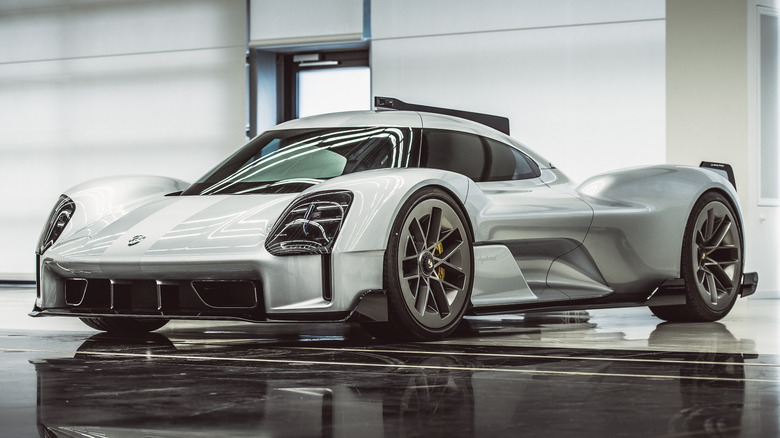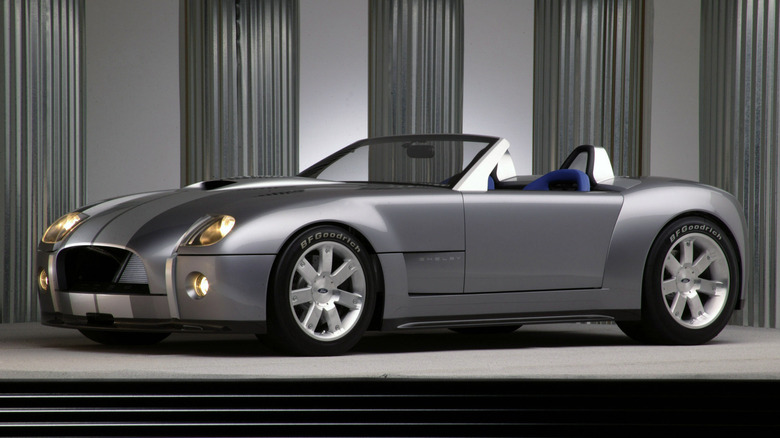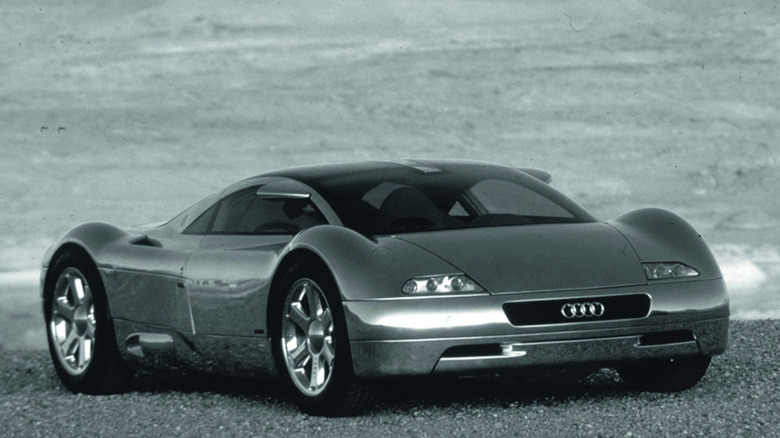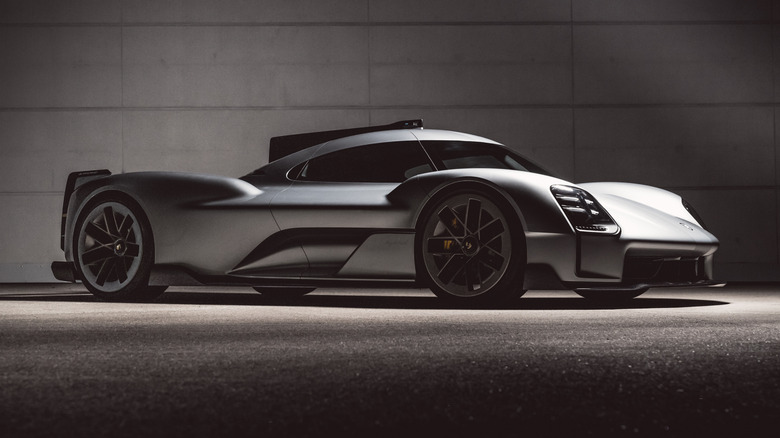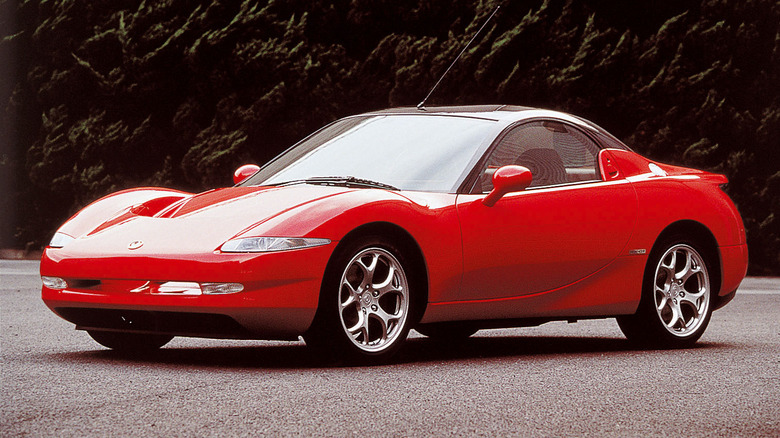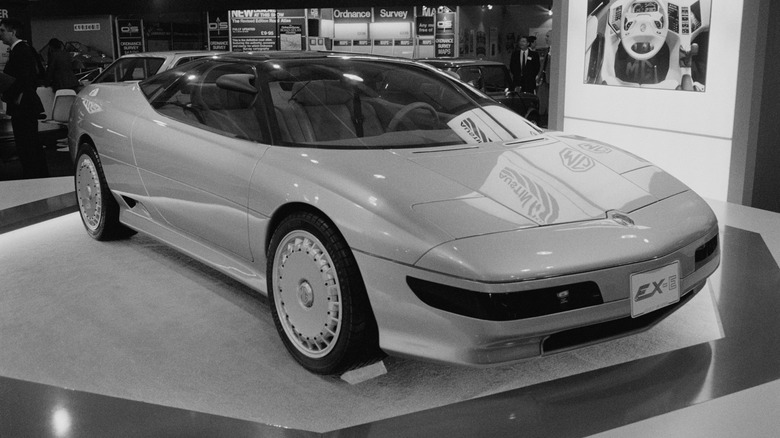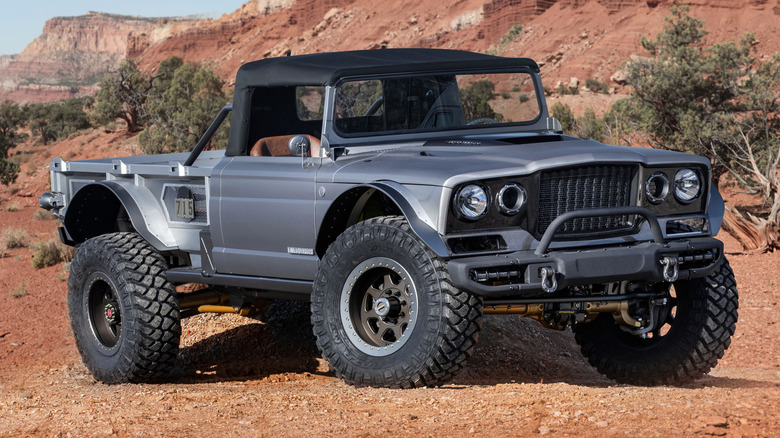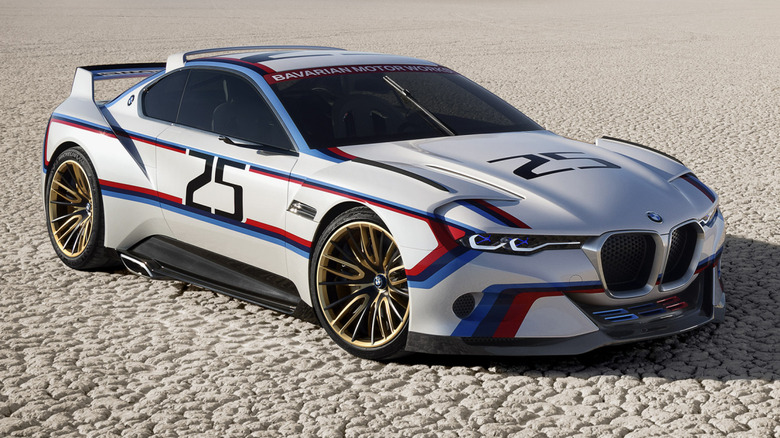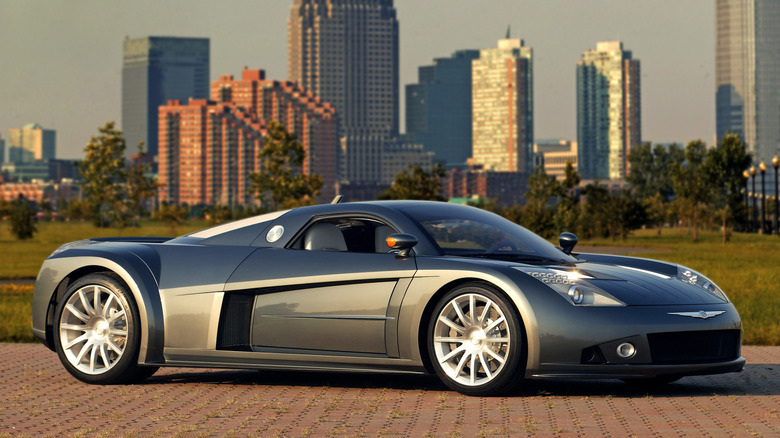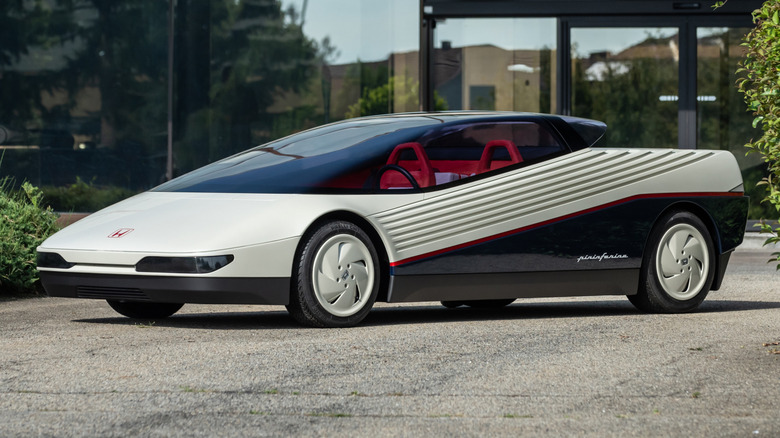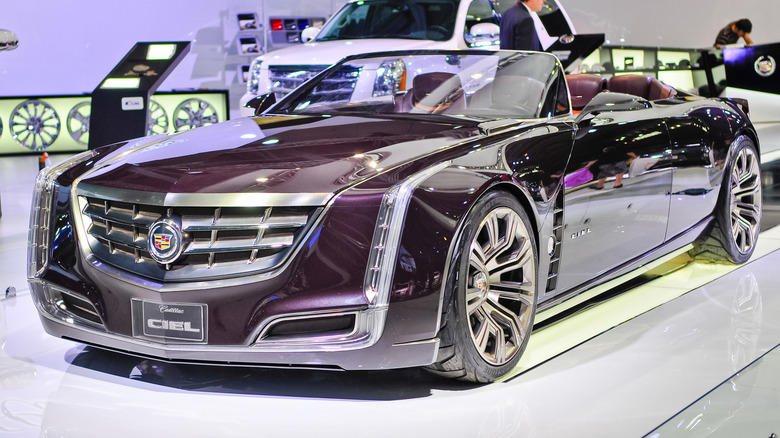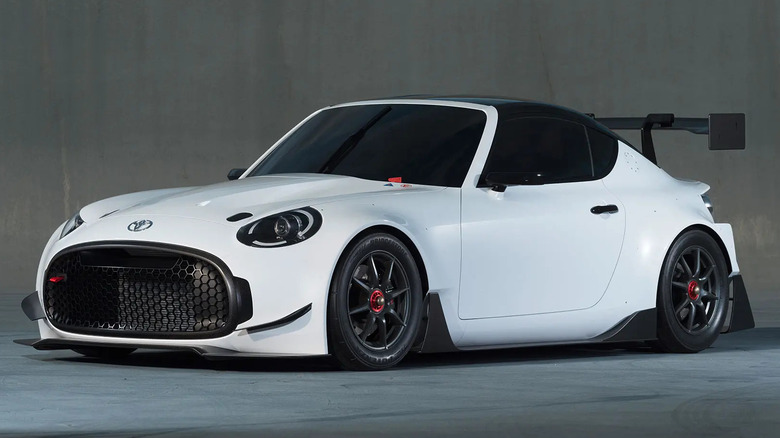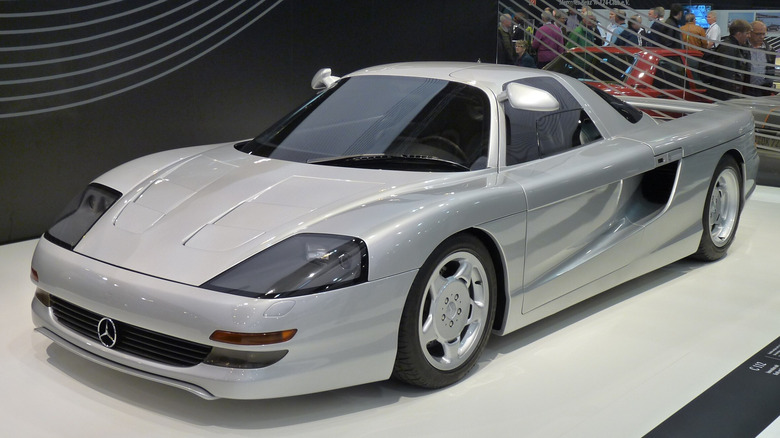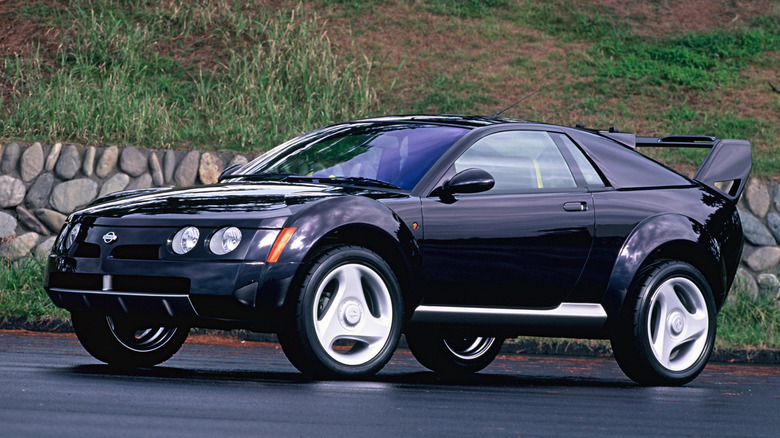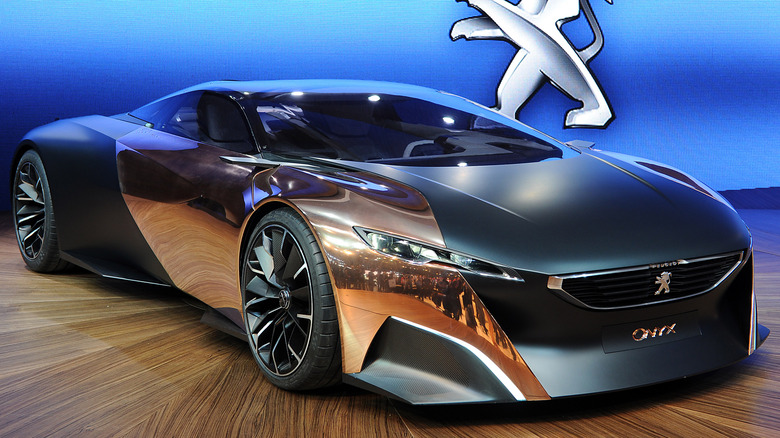14 Of The Coolest Concept Cars We Wish Were Real
Concepts play an important role in the automotive industry, letting manufacturers show off their latest ideas and receive feedback from the press and public that can influence the direction of future production models. In rare cases, manufacturers choose to put their concepts into production unaltered, but in the vast majority of cases, concept cars tend to remain as one-off showpieces even if they share some similarities with a production model.
For manufacturers, the biggest hurdle between concept and production is often financial constraints. Concepts give them a chance to display their wildest, most forward-thinking ideas, but to move forward with production, they need to find a business case for the car. Often, there isn't one, and that means that a lot of particularly cool concepts never become real, driveable production vehicles. Here are a few of our favorite concepts that never made it to production from years gone by, and the stories of what happened after they were first unveiled.
Ford Shelby Cobra Concept
Originally created to be a rival to the Dodge Viper, the Ford Shelby Cobra Concept was more than a simple show car. It was fully drivable and showcased to journalists by none other than Carroll Shelby before its official unveiling. According to MotorTrend, Shelby racked up around 150 miles in the car around the Irwindale Speedway.
The concept's chassis borrowed design elements from the GT, but the V10 that sat under the hood was unique. It was naturally aspirated and churned out just over 600 hp, with the idea that a production version could be turbocharged if needed later down the line. Unfortunately, that planned production run never came to be, as Ford bosses decided not to press ahead with the project. Nicknamed "Daisy," the car was put into storage for over a decade, and eventually sold off in 2017.
Luckily, the buyer of the concept was the original chief engineer of the project. He restored the Cobra to its original glory, and even managed to make it road legal. The Cobra later sold at auction in 2021 for $2.64 million, and it remains a completely unique piece of Ford and Shelby history.
Audi Avus Quattro
Long before anyone had heard of an Audi R8, the German automaker had already unveiled a mid-engined supercar. It even had a W12 engine — sort of. The Avus Quattro concept debuted in 1991 as little more than a marketing stunt, intended to showcase the brand's upcoming W12 engine and aluminum bodywork. The brand's flagship A8 sedan was set to receive both of these innovations, but rather than simply debut the new A8 in production form, Audi created a supercar design to draw headlines instead.
At the time, Audi claimed that the Avus Quattro churned out over 500 hp and could reach a top speed north of 200 mph. That wasn't actually true, in fact the concept couldn't even move under its own power, as it didn't have a real engine. The engine that can be seen under the Avus Quattro's cover is instead a mockup made from wood, since Audi's development team hadn't finished building the first real W12 engines.
Audi never intended to build a production version of the car, but clearly the idea of a mid-engine supercar proved enticing enough to warrant further development. In 2000, the brand unveiled the Rosemeyer, a concept with an 8.0-liter W16 engine and a design inspired by Auto Union racers of the 1930s. It never made production, but its engine was later used in the Bugatti Veyron. Audi's next supercar concept was the Le Mans Quattro, which eventually became the production R8.
Porsche 919 Street
Not every concept car is designed for the public eye. The Porsche 919 Street was initially nothing more than an internal design exercise, intended to explore the idea of making a road-legal version of the brand's 919 race car. It was first developed in 2017, but remained hidden from the public until 2020, when Porsche unveiled a series of previously unseen concepts in the book "Porsche Unseen."
A 2023 social media post by the Porsche Museum added some extra details to the idea: "Technically, the 919 Street would have used the same carbon monocoque, axles and drivetrain as the racing version, making it a 900 PS+ hypercar." However, the 919 Street never got past the idea stage, and in fact even the pictured car is a clay model and not a functional prototype. Porsche decided that adapting the 919's powertrain and bodywork to meet global road regulations would have been too costly, and so the idea was shelved.
According to the Porsche Museum, it receives regular enquiries from enthusiasts about whether there are any plans to put the 919 Street into production. Unfortunately, a production version was never seriously considered, and the 919 race car has since been succeeded by the 963 hypercar, Porsche's most expensive model ever.
Mazda RX-01
The Mazda RX-01 was unveiled in 1995, pitched as a preview of what Mazda's future road cars would look like. At the time, the company was still producing the FD RX-7, which wasn't exactly setting sales charts on fire. Company representatives had acknowledged to journalists that changes needed to be made to the brand's sports car lineup, but insisted that the rotary engine wasn't going anywhere. That turned out to be true, at least for the RX-7's successor, the RX-8.
First launched in 2003, the production RX-8 borrowed the engine from the RX-01 concept, but much of its styling wasn't carried over. The RX-01 was intended to be more lightweight, more simple, and less expensive than the RX-7, drawing a wider set of buyers without alienating the current RX-7's buyer base. However, the production RX-8 tried to be the best of both worlds, being cheaper and less powerful but still being (unconvincingly) pitched as a true RX-7 successor.
Mazda discontinued the RX-8 at the start of the 2010s, marking the end of the brand's rotary-powered sports car line. Whether the story would have been any different had the original RX-01 made production as a cheaper alternative to the RX-7 is debatable. Perhaps having two distinct rotary sports cars, one top spec and one much cheaper, might have been enough to tempt buyers. Either way, it's a shame we never got to try out the RX-01 for ourselves.
MG EX-E
Bringing a car brand back from the dead is far from easy, but China's SAIC Motor has managed to do it with MG. In its home country, the U.K., MG has firmly reestablished a foothold in the market, with its HS crossover being one of the best-selling cars in the country in 2024. Today, MG's lineup consists mostly of budget-oriented crossovers and hatchbacks, but in decades past, when it was still under the ownership of British Leyland, it had grander plans. Unveiled in 1985, the EX-E was intended to be MG's most ambitious car ever, a supercar with a 3.0-liter V6 engine borrowed from the Metro 6R4 Group B rally car.
It was designed to shock, taking styling influence from exotics like the Lotus Esprit and Ferrari 308 as well as military fighter jets of the era. This resulted to a final design unlike anything else the company had ever unveiled. There was reportedly enthusiasm from bosses about putting the car into production, but it was calculated to be far too expensive to justify further development. The EX-E concept eventually remained a one-off, and today it's housed in the British Motor Museum. MG would survive for a further two decades after the EX-E was axed, until the Rover Group went bankrupt in the mid-'00s.
Jeep M-715 Five-Quarter
The Jeep M-715 Five-Quarter blends old and new into one very cool restomod concept, with the body of a 1968 M-715, the chassis of a modern Gladiator pickup, and a 6.2-liter Hellcrate Hemi V8 engine under the hood. It was one of several concepts that Jeep took to the 2019 Moab Easter Safari, and like the rest of them, it's a fully functional one-off. The panels are built from a mix of carbon fiber and aluminum to keep weight down, and since the V8 engine makes 700 hp, the concept can hustle when it needs to.
Except, it doesn't usually need to. Jeep built the concept primarily as a rock crawler, and to that extent, it's fitted with huge 40-inch tires, Dynatrac Pro-rock axles, and rock rails. Jeep's rivals have made similarly over-the-top pickups into production vehicles — for example, the Ram TRX and Ford F-150 Raptor R — but neither of those sport the retro looks of the Five-Quarter concept. Had it decided to create a limited run of production vehicles for well-heeled off-road enthusiasts, Jeep would have had a unique entry into the super-truck segment, but sadly the M-715 Five Quarter was only intended to be a showpiece.
BMW 3.0 CSL Hommage R
BMW has a habit of creating stunning concepts and then not putting them into production. A prime example is the BMW 3.0 CSL Hommage R, which debuted at the Pebble Beach Concours d'Elegance in 2015. It was created to celebrate the 40th anniversary of BMW's racing debut in North America, with the brand's 3.0 CSL competition car announcing its debut by winning its maiden IMSA championship. The 3.0 CSL Hommage R pays tribute to that original '70s race car, both in its exterior styling and in its livery.
The 2015 concept was constructed primarily from carbon fiber to keep its weight to a minimum. BMW didn't disclose what powertrain lay under the concept's hood, nor did it disclose any performance figures. Much to the disappointment of many enthusiasts, the 3.0 CSL Hommage R was designed solely as a show car, and so performance would have been irrelevant anyway.
Its unveiling triggered an inevitable round of speculation about whether the concept would influence a future production car, even if the concept itself wasn't destined for production. Arguably, the BMW M2, unveiled a year later than the 3.0 CSL Hommage R, has a hint of the concept's design about it, but the closest production successor is undoubtedly the 2023 3.0 CSL. So, although the concept itself was never made into a real production car, it's probably the closest any of the concepts here have become to being produced.
Chrysler ME Four-Twelve
While Dodge, Ford, Chevrolet, and most other major American brands have a rich back catalog of performance models from the 21st century, Chrysler's back catalog is thin. Sure, it made some hotter versions of models like the Crossfire and the 300, but it hasn't revealed a blockbuster performance model in decades. At least, not in production form. The ME Four-Twelve nearly changed that, but it proved to be too bold a step for the brand's leadership to justify.
Chrysler took the covers off the ME Four-Twelve in 2004, and at the time it seemed pretty serious about considering the car for production. The low-slung, mid-engine supercar with its quad-turbo 6.0-liter V12 engine was a world away from anything that Chrysler had produced before, but it was no mere design study. The brand's engineers had developed a fully working prototype with a chassis built from carbon fiber and aluminum, and the V12 engine was a modified version of the production AMG M275 engine. Those modifications allowed it to put out a claimed 850 hp.
Unfortunately, like most of the cars here, the business case for building the car was not anywhere near as strong as the enthusiast case for its existence. Chrysler simply couldn't make the numbers work, with the forecasted pricing for the car ballooning until the project was eventually shelved altogether.
Honda HP-X
Arguably one of the coolest Honda concepts ever built, the HP-X was one of the brand's earliest ideas for a supercar. With no previous experience to draw from, the Japanese automaker enlisted the help of Pininfarina to create an attractive supercar design, and borrowed a V6 engine from its F2 racing program. As well as its looks, the HPX's construction was also unique, with carbon fiber and honeycomb panels keeping its weight to a minimum.
Eventually, Honda decided not to press ahead with production, although it kept experimenting with the idea of creating a supercar. Eventually, that supercar would arrive in the form of the legendary Acura NSX. Some of the HP-X's design elements, including its honeycomb frame, were carried over to the production NSX. Honda kept its HP-X concept in storage, and to celebrate the 40th anniversary of its unveiling, it restored it and showed it off at the Pebble Beach Concours d'Elegance in 2024.
Cadillac Ciel
These days, buyers don't tend to gravitate toward convertibles in the numbers they once did. Perhaps that's because no convertible offered today looks as stately as the Cadillac Ciel. First shown off in 2011, the Ciel was a modern interpretation of the golden era Cadillac drop-top, with a 125-inch wheelbase and an innovative hybrid V6 powertrain with limited all-electric range. The public reaction to its unveiling was very positive, and before long, Cadillac spokespeople had confirmed that the automaker intended to develop a production version.
Initial reports suggested that Cadillac would launch the production car in the mid-2010s, but it was not to be. By 2013, bosses confirmed that the Ciel-derived production car had been canned due to high development costs, but its underlying platform would underpin a slightly less opulent luxury vehicle to rival the Mercedes-Benz S-Class sedan. That sedan would turn out to be the 2017 Cadillac CT6, which was axed after just four years in production due to low sales.
Toyota S-FR Racing
It's been long enough since the original Toyota S-FR concept debuted for it to have become one more Toyota model enthusiasts have forgotten about. The S-FR and its track-oriented Racing counterpart (pictured above) were intended to be entry-level Toyota sports cars, smaller and cheaper than the 86. It featured a front-mid mounted engine and rear wheel drive, plus a six-speed manual transmission. The racing version added a body kit made from CFRP and a new set of track-ready wheels.
Despite years of rumors, Toyota has not officially confirmed the future of the S-FR to date. Various reports have emerged that a production version might eventually be unveiled, including a 2024 report that claimed the S-FR was on track for a 2026 launch and it would be a joint project with Daihatsu and Suzuki. Enthusiasts can all hope that the report is correct, but given the many years of prior speculation surrounding the car, it's probably not worth getting excited about it until Toyota formally announces a production run.
Mercedes-Benz C112
It takes a very special kind of concept to drum up enough provisional orders for a production run after just one motor show. Yet, that's exactly what the Mercedes-Benz C112 managed. Around 700 people reportedly tried to put their name on the car's non-existent waiting list after it debuted at the Frankfurt Motor Show in 1991, but Mercedes still didn't greenlight it for production. The reason was simple: development costs would have been enormous.
The automaker had already invested heavily in other areas of its lineup and simply didn't have the cash to turn the C112's futuristic tech and racing-derived design into something that could feasibly wear a licence plate. With active aero, traction control, and even intelligent cruise control, the car would have been as technologically advanced as some of today's supercars — except, it was unveiled over three decades ago. Only one fully functional concept was built, complete with a V12 engine making around 400 hp, and it remains under Mercedes' ownership today.
Nissan Trailrunner
Crossovers and SUVs continue to grow in popularity with buyers, with the past decade seeing a huge spike in market share for both segments. Most crossovers now follow a similar formula, but back in the '90s, that formula had yet to be solidified. That resulted in some wild attempts to fuse car and SUV styling into one usable package, such as the Nissan Trailrunner. Unveiled in 1997, the Trailrunner combined all-wheel drive and ride height with sports car styling to create what Nissan thought was "the type of vehicle that will be desired by the next generation of young people."
The Trailrunner boasted a ground clearance of 7.9 inches, more than that of the current Nissan Pathfinder Rock Creek, and an SR20 engine making around 187 hp. It was designed to be sporty on and off the road, while also featuring cutting edge tech like assistive braking and the brand's in-car navigation system. Nissan reportedly considered putting the Trailrunner into production but ultimately decided it was too risky, and unveiled the more conventionally styled X-Trail/Rogue in its place a few years later.
Peugeot Onyx
Peugeot called its Onyx concept an "audacious use of materials," with the most immediately noticeable aspect being the copper bodywork covering its wings and doors. The 2012 concept was just one in a line of Peugeot supercar concepts, with the V12-powered 907, the futuristic Oxia, and the Group B-derived Quasar before it. Unlike all of its predecessors, the Onyx featured a hybrid 3.7-liter V8 powertrain with over 600 hp on tap.
As well as the copper paneling, the Onyx also made liberal use of carbon fiber throughout its construction. In the cabin, the accents were made of what Peugeot called "newspaper wood," which, as its name suggests, was made from recycled newspaper. Other trim elements used hand-blown glass and aluminum. Despite its decades-long history of making one-off concept supercars with complete powertrains and interiors, Peugeot has never actually put any of them into production. While that's a shame, it's probably safe to say that finding willing buyers for a six- or even seven-figure Peugeot would be hard, even for a car as striking as the Onyx.
